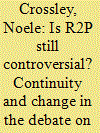| Srl | Item |
| 1 |
ID:
166580


|
|
|
|
|
| Summary/Abstract |
This article analyses competing discourses on a postmodern world order perpetuated by the United States and the People’s Republic of China (PRC), which are themselves built on their own pre-modern or early modern (inter)state models. Among several dimensions of the growing struggle between the two superpowers, this article focuses on their contestation of global norms or the standard of civilization regarding the question of world governance. What is unique in the contemporary competition between America and China is the fact that both countries aim to alter the fundamental organizing principle of modern world politics; they are against not only the balance of power system but also the imperial order, both of which originated from the modern European system. Indeed, Washington and Beijing strive to offer a third organizing principle beyond the conventional dyad in the modern discipline of international relations (IR) of anarchy and hierarchy. In terms of an analytic framework, this article explores the constitutive processes of self-identity formation in America and China against the European other (the Westphalian system and imperialism), thereby demonstrating the two states’ exceptionalist doctrines and their alternative visions for a postmodern world order.
|
|
|
|
|
|
|
|
|
|
|
|
|
|
|
|
| 2 |
ID:
166582


|
|
|
|
|
| Summary/Abstract |
Existing research on the European Union’s (EU) activities at the international level typically pertains to how the EU acts, bargains and performs. However, scholarship less frequently examines how the EU formulates its negotiating strategy at international negotiation fora. Our analysis attempts to fill this gap by presenting an analytical framework to map the different features and parameters that determine and condition the EU negotiating strategy in multilateral contexts. We identify four features in two phases that shape the EU negotiating strategy: (a) goal-setting, (b) field analysis, (c) available means and (d) employed tactics. Each of these features contains additional parameters that, overall, define and constrain the EU’s negotiating strategy. To test the relevance of our analytical framework, we delve into the determination of the EU human rights negotiating strategy at the United Nations.
|
|
|
|
|
|
|
|
|
|
|
|
|
|
|
|
| 3 |
ID:
166581


|
|
|
|
|
| Summary/Abstract |
Is the responsibility to protect (R2P) still controversial? The question is important because if R2P was no longer controversial, this would suggest that the principle is on track to consolidation as an international norm. The article assesses the impact of 16 years of sustained R2P advocacy and its influence on arguments within the scholarly community, and discusses the impact this engagement has had on the outline and substance of the principle itself. A survey of the development of the academic debate since 2005 suggests that the ‘responsibility to protect’ has successfully replaced ‘humanitarian intervention’ in international discourse, but that the principle remains controversial, especially beyond the policy community, particularly in the world of academe, in the humanitarian aid sector and religious organizations and with states with a colonial past.
|
|
|
|
|
|
|
|
|
|
|
|
|
|
|
|
| 4 |
ID:
166579


|
|
|
|
|
| Summary/Abstract |
This article seeks to determine why the illegal wildlife trade is still flourishing in China despite the country’s adoption of the Convention on International Trade in Endangered Species of Wild Flora and Fauna (CITES). It focuses on the 1989 international trade ban on African elephant ivory. Taking a normative social constructivist approach, the article illuminates the motivations for, and processes and consequences of, accommodating novel norms in domestic situations. In addition, China is compared with Japan to ensure both methodological rigour and wide empirical coverage. It is argued that, although species protection has been adopted as a legitimate transnational norm, it has not been sufficiently socialized into Chinese (or Japanese) society. Rather, related local issues and social, cultural and economic factors play crucial roles in driving ivory demand and trade. Thus, despite the adoption of a relevant regulatory framework, illegal wildlife trade has become a serious problem in today’s highly commercialized Chinese (and Japanese) society. This problem can be solved only by conforming to international conservation norms and implementing stringent regulations and effective governance.
|
|
|
|
|
|
|
|
|
|
|
|
|
|
|
|